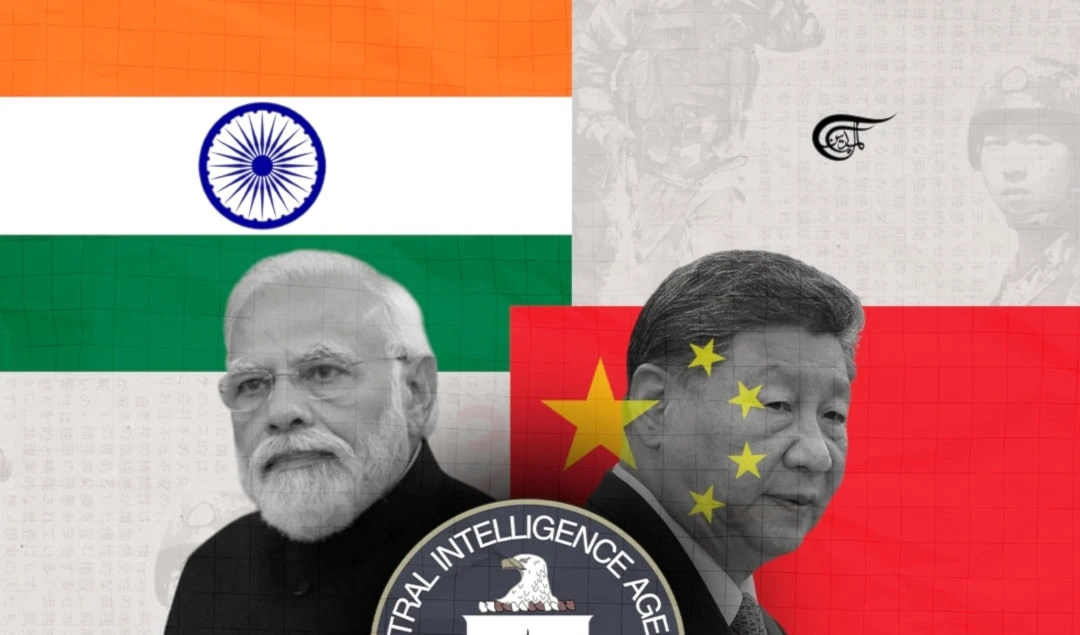China, the construction of multipolar world, and the pursuit of sovereignty
From CIPS to BRICS+ and initiatives like Belt and Road, Beijing offers the Global South tools for financial autonomy, strategic alliances, and development beyond US hegemony.
-

China is reshaping the global order, offering the Global South financial autonomy and alliances beyond US dominance (Illustrated by Zeinab al-Hajj; Al Mayadeen English)
The rise of China and the crisis of the unipolar order
At a historic moment when the Western liberal order shows clear signs of exhaustion—eroded by its own internal contradictions, the instrumentalization of the global financial system, the economic and moral wear caused by continuous military adventures against countries of the Global South, and its inability to offer solutions to systemic crises—China emerges not merely as an economic competitor, but as the architect of a geopolitical alternative. With 18% of global GDP in purchasing power parity terms, the planet’s largest manufacturing capacity (producing over 30% of global industrial goods), global leadership in electric vehicles, solar panels, batteries, and 5G networks, and a trade network spanning more than 150 countries, China is no longer an emerging power: it is the only nation with the economic, technological, financial, and diplomatic scale capable of seriously challenging US unipolar hegemony.
Faced with this reality, Western elites have revived the old rhetoric of the “Yellow Peril”—a racist and manipulative narrative that seeks to criminalize the peaceful rise of a non-Western country and justify policies of containment, blockade, and confrontation. But the real threat is not China; it is the possibility that the Global South might fail to access a more just, plural, and sovereign order.
China’s strategy does not aim simply to displace Washington, but rather—through historical patience and strategic pragmatism—to weave the pillars of a multipolar world in which power is no longer concentrated in a single pole, but distributed among multiple centers of sovereign decision-making.
Mechanisms of financial autonomy and strategic alliances
This transformation extends beyond trade or technology. It manifests more profoundly in the reconfiguration of the international financial system, the creation of parallel institutions, and the articulation of new South–South alliances that openly challenge dollar hegemony, neoliberal conditionality, and the interventionist logic that has characterized the post-1945 order.
One of the most decisive fronts in this battle is finance. For decades, SWIFT—the Society for Worldwide Interbank Financial Telecommunication—has functioned as the invisible backbone of global commerce and as a tool of geopolitical coercion. The disconnection of Iran, Cuba’s longstanding exclusion, and more recently, the removal of Russian banks following the war in Ukraine, illustrate how financial interdependence can become “belligerent interdependence”—a pressure mechanism allowing Washington to punish those who defy its order.
In response to this systemic vulnerability, China has developed the Cross-Border Interbank Payment System (CIPS)—an infrastructure that, while not replacing SWIFT, offers a sovereign, more efficient, and less costly channel for international transactions. With over 1,400 institutions connected across 110 countries and a daily transaction volume exceeding $83 billion (2025 projection), CIPS not only facilitates trade in yuan but also strengthens the financial autonomy of nations—particularly in the Global South—that have historically suffered from the extraterritorial reach of US power.
Simultaneously, China is promoting geopolitical blocs that reshape the global power map.
The BRICS+, which from its original membership of Brazil, Russia, India, China and South Africa expanded in 2025 to include ten associate states—Belarus, Bolivia, Cuba, Kazakhstan, Malaysia, Nigeria, Thailand, Uganda, Uzbekistan, and Vietnam—now represents around 50% of the world’s population and 43.93% of global GDP in purchasing power parity terms. Yet, its significance goes beyond statistics: by bringing together the world’s leading oil and gas producers—controlling over 40% of global reserves (Venezuela, with the bigger reserves in the world, is not a member, however it is considered a country that could form part of the group in the future) —and now also incorporating strategic actors from the Caribbean, the Southern Cone, and Southeast Asia, the bloc has acquired unprecedented geopolitical weight.
Cuba’s inclusion—historically a symbol of anti-imperialist resistance in Latin America, with a small economy but a vast medical, scientific, educational, ethical, solidarity-based, and diplomatic capital—marks a shift of notable significance: for the first time, a socialist Third World country that has resisted more than six decades of blockade joins the core of a bloc aspiring to redefine the global order away from neoliberalism and toward fraternity. This reinforces the BRICS+’s plurinational, anti-hegemonic, and civilizational diversity, distancing it even further from the exclusive G7 club.
However, beneath its discourse of South–South solidarity and equitable multipolarity, historical bilateral tensions persist (traditionally between India and China), alongside ideological differences and often contradictory energy and geopolitical agendas. Thus, BRICS+ is not a unified front, but a complex negotiating space where cooperation and competition coexist.
The "de-dollarization” driven by CIPS or BRICS+ entails replacing the dollar with another viable currency or with a multipolar system of strong currencies (yuan, ruble, real, rupee). Indeed, the New Development Bank of BRICS+ is free from the explicit conditionality of the Washington Consensus, although it still operates according to the logic of profitability and fiscal sustainability.
An alternative civilizational vision
Beyond institutional mechanisms, China frames its global projection around a clearly defined normative vision: the “Community of Shared Future for Humanity.” Elevated to a pillar of its foreign policy, this concept is not mere diplomatic rhetoric, but a civilizational proposal that rejects the zero-sum confrontation logic of the Western order and instead promotes mutual cooperation, respect for sovereignty, and joint development.
In this spirit lies the Belt and Road Initiative (BRI), conceived not as a strategy of domination, but as a network of physical and digital corridors aimed at connecting continents through infrastructure, trade, and cultural dialogue. Unlike Western aid programs—conditioned on neoliberal reforms, structural adjustments, or political alignment—the BRI is presented under the principles of “joint consultation, co-construction, and shared benefits,” without demanding changes to political models or imposing economic doctrines.
This philosophy, together with proposals like the “Global Development Initiative” and the promotion of inclusive multilateralism, constitutes a profound challenge to the foundations of the US-led international order: it does not seek to replace one empire with another, but to build a more plural, difference-respecting, and common-good-oriented system.
Latin America on the multipolar chessboard
In this context, Latin America becomes a key arena. Historically trapped in the dynamics of dependency, the region now sees China as an opportunity to diversify partners and break from its traditional subordination to the West. Yet opposing forces exist: on one side, oligarchic interests subordinate to the United States and Western capitalism; on the other, those who genuinely support deeper relations but simultaneously aim to protect national interests and avoid the establishment of a new form of dependency based on “re-primarization”—a phenomenon that generates an economic model centered on raw material exports, relative loss of industrial capacity, and increased subordination to global market cycles.
These actors advocate for strategic negotiations to prevent the reproduction of asymmetries, ensure sufficient local value-added creation, promote industrialization, and secure substantial technology transfers. This debate is not academic—it translates into concrete policies.
Venezuela and Nicaragua represent paradigmatic cases of how the pursuit of national sovereignty intertwines with the construction of a multipolar order. Both countries, subjected for decades to unilateral sanctions, financial blockades, and destabilization operations orchestrated from Washington, have found in China a strategic ally that respects their right to self-determination. In Venezuela, relations with China have strengthened in vital sectors such as energy, telecommunications, and infrastructure, with investments that—though hampered by restrictions imposed by the US-dominated global financial system—have allowed the country to maintain a degree of autonomy in managing its oil and strategic mineral resources.
Nicaragua, for its part, has deepened its integration with China in areas such as agriculture, health, and digital connectivity, while reinforcing its diplomatic alignment with the principle of non-interference. For both governments, cooperation with China is not merely a commercial exchange but part of a civilizational resistance strategy against imperialism, in which multipolarity becomes a necessary condition for preserving their political and social models in the face of Western unilateralism.
While countries like Brazil, Chile, and Peru have forged multifaceted alliances with China—from deep trade agreements to mega-infrastructure projects like the Chancay port or investments in lithium and renewable energy—others have taken radically different paths. Argentina, under the government of Javier Milei—who repeatedly insulted China during his presidential campaign—has been forced to combine alignment with Washington with the maintenance of an economic relationship with China based on agro-industrial exports and scientific cooperation.
Mexico, meanwhile, must struggle to avoid the risks of hyper-dependence, with 80% of its exports tied to the US market, and seek openings for relations with China. On the other hand, trade wars between Washington and Beijing, combined with migration and security pressures under the Trump administration, pose real threats to the country. Supply chain re-localization as an escape route requires time, structural reforms, legal certainty, and a modern energy infrastructure.
Cuba: Between blockade and shared destiny
In this scenario, Cuba occupies a singular place. Its incorporation into BRICS+ is not merely diplomatic recognition, but the materialization of a bilateral relationship with China that has deepened within the framework of the “Community of Shared Future”—a concept that, in the Cuban case, takes on a distinctly anti-imperialist content.
Opportunities are significant: cooperation in biotechnology, medicine, renewable energy, 5G telecommunications, and port infrastructure development. China is already one of the island’s main trading partners and has shown willingness to invest in strategic sectors without demanding neoliberal opening or privatizations.
However, structural limitations persist. The US blockade—reinforced by numerous “sanctions” introduced under the Trump administration, on top of traditional measures and especially the infamous Helms-Burton Act—prevents, despite the friendly bilateral relations, many Chinese companies from freely operating with Cuba due to fear of retaliation in the US market. Additionally, Cuba’s own economy—facing foreign exchange constraints, production limitations, and import dependency, largely caused by the blockade—reduces the scale and scope of potential projects.
Nevertheless, the strategic alliance between Havana and Beijing transcends economics: it is a civilizational alliance between two projects that challenge Western hegemony. For Cuba, China represents not only a commercial partner but an ally in defending sovereignty, non-interference, and the right to self-determined development—values that fully align with the foundational principles of the Cuban Revolution.
Contemporary multipolarity and an emancipatory horizon
For its part, China does not impose its model. Its approach in Latin America is based on economic complementarity, non-interference in internal affairs, and the promotion of multilateral mechanisms such as the China–CELAC Forum. It has made the region its second-most important trading partner, with bilateral trade exceeding $518 billion in 2024, and has channeled investments into strategic sectors without demanding structural adjustments.
Herein lies one of the central tensions of the emerging order: the multipolarity now taking shape offers genuine hope for humanity, yet it still operates within the capitalist formulas of the existing international order, with their inherent injustices and contradictions. It is not the final solution to the root causes of the problems affecting the Global South, and it unfolds alongside the dangerous and aggressive death throes of US imperialism and Western capitalism.
Indeed, at present, China contests the global capitalist system “from within. The country currently engages this system by offering a distinctive model of cooperation that merges strategic state planning with deep integration into global value chains. Such an approach generates tangible advantages for its partners in Africa, Asia, and Latin America: Chinese investments serve mutual interests by securing raw materials for the Asian giant while simultaneously opening new markets for its partners' goods and expanding their access to financing. This dynamism provides a palpable stimulus for development, all without the stringent conditionalities often imposed by institutions like the IMF or the World Bank. To fully maximize these benefits, however, this relationship requires careful navigation and a long-term vision. The objective must be to channel these investments toward genuine, diversified, productive transformation, thereby avoiding the reinforcement of extractive dependencies and instead consolidating sovereign and sustainable development.
However, in China’s case, a fundamental historical contrast must be emphasized: unlike Western powers, whose expansion was built on centuries of colonialism, slavery, plunder, and wars of conquest, the Chinese historical record reveals no imperialist conduct or ambitions of territorial domination. There is no tradition of colonial exploitation. For centuries, the Chinese tributary system—often misinterpreted as domination—functioned as a symbolic framework for the recognition of China as a fundamental cultural center in East Asia, operating without foreign administrative imposition, systematic surplus extraction, or the destruction of local cultures. In contrast, the influence of Chinese civilization profoundly enriched the cultures across East Asia.
Tactics of resistance, strategy of emancipation
Countries of the Global South must understand that multipolarity should be viewed both as a tactic of resistance and as part of an emancipatory strategy. Tactically, partially escaping—even if incompletely—from the constraints of the unipolar order is not only important but urgent. Dollar financial hegemony, extraterritorial sanctions, supply chains controlled by Western corporations, and technological subordination are concrete mechanisms of domination that suffocate Southern sovereignty and impoverish nations.
Thus, mechanisms such as CIPS, bilateral agreements in local currencies, participation in BRICS+, or diversification of trade partners are not mere diplomatic maneuvers—they are tools of national defense that create space, shield economies from geopolitical coercion, and preserve the ability to design public policies free from vetoes by Washington or Brussels. In this sense, it is indeed crucial to break with the impositions of the current order. Failing to do so would mean accepting permanent subordination.
Let us not be confused: the phenomenon represented by China’s contemporary international role is absolutely positive and hopeful for the Global South and humanity as a whole.
Strategically, however, the Global South cannot settle for this first—though very important—objective. It must move toward transforming relations of production, democratizing access to technology, challenging extractivism, and strengthening workers’ and peoples’ rights.
Therefore, the Left must embrace a dual task:
1) Tactically leverage the spaces opened by the crisis of unipolarity, deepen relations with China, Russia, and other alternative countries to strengthen economic sovereignty, regain control over strategic resources, and build autonomous infrastructure—including energy, logistics, and telecommunications.
2) Simultaneously, strategically advance an agenda promoting South–South integration based on solidarity, complementarity, reciprocity, and planning—demanding that foreign investments include genuine technology transfer, local content, and environmental respect; and, above all, linking foreign policy with internal transformation: agrarian reform, industrialization with social justice, enhance education of people, and food and energy sovereignty.
In summary: escaping the impositions of the current order is imperative, but strategically, the Global South must be clear about the kind of society it aims to build. Latin America, with its history of anti-imperialist struggles and experiences of popular integration, bears the historical responsibility of becoming an active subject in the construction of a more just order. Multipolarity may offer the historical opportunity—the necessary space—for the organized and conscious peoples of the South to build it.
Bibliography:
- Amin, Samir (2011). La desglobalización: un proyecto para el Sur. Siglo XXI Editores.
- Arrighi, Giovanni (2007). Adam Smith en Pekín: orígenes y fundamentos del siglo XXI. Akal.
- Boron, Atilio (2002). Imperialismo y hegemonía: Estados Unidos y América Latina en la era de Bush. CLACSO.
- Grosfoguel, Ramón (2007). El giro decolonial. Reflexiones para una diversidad epistémica más allá del capitalismo globa (coeditado con Santiago Castro-Gómez). Universidad Nacional de Colombia.
- Wallerstein, Immanuel (2011). El sistema-mundo moderno, Vol. IV. Siglo XXI.
- Gallagher, Kevin P. (2016). The China Triangle: Latin America’s China Boom and the Fate of the Washington Consensus. The New Press.
- Bräutigam, Deborah (2009). The Dragon’s Gift: The Real Story of China in Africa. Oxford University Press.
- Hernández, Rafael (2020). Cuba y el orden mundial: desafíos de la soberanía en tiempos de crisis. Editorial de Ciencias Sociales (Cuba).
- Dussel, Enrique (1994). 1492: el encubrimiento del otro. Anthropos.
- People’s Republic of China, Ministry of Foreign Affairs (2023). Global Development Initiative, Global Security Initiative, Global Civilization Initiative. Documentos oficiales.

 Pedro Monzón Barata
Pedro Monzón Barata
 15 Min Read
15 Min Read











